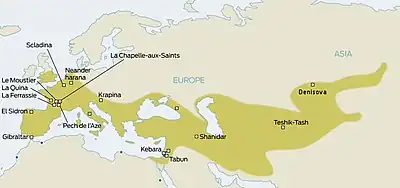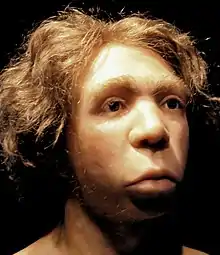 Distribution of Homo neanderthalensis, and main sites. Mousterian industries have been found outside this range (e.g., Jordan, Saudi Arabia) | |
| Geographical range | Africa and Eurasia |
|---|---|
| Period | Middle Paleolithic |
| Dates | c. 160,000–40,000 BP[1] |
| Type site | Le Moustier |
| Major sites | Creswell Crags, Lynford Quarry, Arcy-sur-Cure, Vindija Cave, Atapuerca Mountains, Zafarraya, Gorham's Cave, Devil's Tower, Haua Fteah, Jebel Irhoud |
| Preceded by | Acheulean, Micoquien, Clactonian |
| Followed by | Châtelperronian, Emiran, Baradostian, Aterian, Mal'ta–Buret' culture? |
The Mousterian (or Mode III) is an archaeological industry of stone tools, associated primarily with the Neanderthals in Europe, and to the earliest anatomically modern humans in North Africa and West Asia. The Mousterian largely defines the latter part of the Middle Paleolithic, the middle of the West Eurasian Old Stone Age. It lasted roughly from 160,000 to 40,000 BP. If its predecessor, known as Levallois or Levallois-Mousterian, is included, the range is extended to as early as c. 300,000–200,000 BP.[2] The main following period is the Aurignacian (c. 43,000–28,000 BP) of Homo sapiens.
Naming
The culture was named after the type site of Le Moustier, three superimposed rock shelters in the Dordogne region of France.[3] Similar flintwork has been found all over unglaciated Europe and also the Near East and North Africa. Handaxes, racloirs, and points constitute the industry; sometimes a Levallois technique or another prepared-core technique was employed in making the flint flakes.[4]
Characteristics
.jpg.webp)

The European Mousterian is the product of Neanderthals. It existed roughly from 160,000 to 40,000 BP.[6] Some assemblages, namely those from Pech de l'Aze, include exceptionally small points prepared using the Levallois technique among other prepared core types, causing some researchers to suggest that these flakes take advantage of greater grip strength possessed by Neanderthals.[7]
In North Africa and the Near East, Mousterian tools were produced by anatomically modern humans. In the Eastern Mediterranean, for example, assemblages produced by Neanderthals are indistinguishable from those made by Qafzeh type modern humans.[8] The Mousterian industry in North Africa is estimated to be 315,000 years old.[2]
Possible variants are Denticulate, Charentian (Ferrassie & Quina) named after the Charente region,[9] Typical, and the Mousterian Traditional Acheulian (MTA) Type-A and Type-B.[10] The industry continued alongside the new Châtelperronian industry during the 45,000–40,000 BP period.[11]
Locations
- Mousterian artifacts have been found in Haua Fteah in Cyrenaica and other sites in Northwest Africa.[12]
- Contained within a cave in the Syria region, along with a Neanderthaloid skeleton.[12]
- Located in the Haibak valley of Afghanistan.[12]
- Zagros and Central Iran
- The archaeological site of Atapuerca, Spain, contains Mousterian objects.
- Gorham's Cave in Gibraltar contains Mousterian objects.
- Uzbekistan has sites of Mousterian culture, including Teshik-Tash.[12]
- Turkmenistan also has Mousterian relics.[12]
- Siberia has many sites with Mousterian-style implements, e.g. Denisova Cave.[12]
- Israel is one of the places where remains of both Neandertals and Homo sapiens sapiens have been found in association with Mousterian artifacts.[13]
- Lynford Quarry near Mundford, Norfolk, England, has yielded Mousterian tools.
- The archaeological cave site of Azykh contains Mousterian relics in the overlying strata. In this cave, a lower jaw of a hominid named Azykhantrop has been found. It is supposed that this finding belongs to a pre-neanderthal species.[14][15]
- The most important sites with significant Neanderthal and Mousterian finds in Croatia are Krapina, Vindija, Velika pećina and Veternica, located in the north-western part of Croatia and the region of Hrvatsko zagorje.[16][17][18][19][20] Mousterian industry sites on Istrian peninsula are Romualdova pećina and an open-air site at Campanož.[21] Sites on the Adriatic coast and its hinterland are Mujina pećina, with a Mousterian stratigraphic sequence, and Velika pećina in Kličevica with finds approximately 40,000 years old that are late Mousterian.[22] An underwater Mousterian excavation site at Kaštel Štafilić - Resnik recovered about 100 artefacts of which half are tools, Mousterian centripetal cores and side scrapers, several pseudotools, numerous pieces of chert and Levallois method artifacts.[23][24][25] Other underwater Paleolithic finds are a single Mousterian tool offshore of Povljana on the island of Pag and stone tools of possible Mousterian type at a depth of 3 m at Stipanac in Lake Prokljan.[26] In the area north of the town of Zadar an extensive series of sites exist where usually small Micro-mousterian industry tools, denticulates and notched pieces are found.[25]
 Stone scrapers for cleaning and working leather, Mousterian Culture, Israel, 250,000-50,000 BP
Stone scrapers for cleaning and working leather, Mousterian Culture, Israel, 250,000-50,000 BP
 Levallois points
Levallois points Mousterian Culture and Late Stone Age Stone Tools. Notch for sharpening wood, and denticulate for sawing wood and bone. Rosh En Mor and En Aqev. 250,000-22,000 BP. Israel
Mousterian Culture and Late Stone Age Stone Tools. Notch for sharpening wood, and denticulate for sawing wood and bone. Rosh En Mor and En Aqev. 250,000-22,000 BP. Israel.jpg.webp) Mousterian & Aurignacian Cultures, Stone Burins used for incising stone and wood, Qafzeh, Hayonim, el-Wad Cave, 250,000-22,000 BP Israel
Mousterian & Aurignacian Cultures, Stone Burins used for incising stone and wood, Qafzeh, Hayonim, el-Wad Cave, 250,000-22,000 BP Israel.jpg.webp) Mousterian Culture, stone spearheads, 250,000-50,000. Israel Museum
Mousterian Culture, stone spearheads, 250,000-50,000. Israel Museum
See also
| The Paleolithic |
|---|
| ↑ Pliocene (before Homo) |
| ↓ Mesolithic |
References
- ↑ Callaway, Ewen (20 August 2014). "Neanderthals: Bone technique redrafts prehistory". Nature. 512 (7514): 242. Bibcode:2014Natur.512..242C. doi:10.1038/512242a. ISSN 0028-0836. PMID 25143094.
From the Black Sea to the Atlantic coast of France, these [Mousterian] artefacts and Neanderthal remains disappear from European sites at roughly the same time, 39,000–41,000 years ago, Higham's team conclude. The data challenge arguments that Neanderthals endured in refuges in the southern Iberian Peninsula until as recently as 28,000 years ago
- 1 2 Richter, Daniel; Grün, Rainer; Joannes-Boyau, Renaud; Steele, Teresa E.; Amani, Fethi; Rué, Mathieu; Fernandes, Paul; Raynal, Jean-Paul; Geraads, Denis (2017-06-07). "The age of the hominin fossils from Jebel Irhoud, Morocco, and the origins of the Middle Stone Age". Nature. 546 (7657): 293–296. Bibcode:2017Natur.546..293R. doi:10.1038/nature22335. ISSN 0028-0836. PMID 28593967. S2CID 205255853.
- ↑ Haviland, William A.; Prins, Harald E. L.; Walrath, Dana; McBride, Bunny (24 February 2009). The Essence of Anthropology. Cengage Learning. p. 87. ISBN 978-0-495-59981-4. Retrieved 23 November 2011.
- ↑ Aldenderfer, Mark; Andrea, Alfred J.; McGeough, Kevin; Mierse, William E.; Neel, Carolyn (29 April 2010). World History Encyclopedia. ABC-CLIO. p. 330. ISBN 978-1-85109-929-0. Retrieved 23 November 2011.
- ↑ Bekker, Henk (23 October 2017). "Neues Museum in Berlin 1175".
- ↑ Shaw, Ian; Jameson, Robert, eds. (1999). A Dictionary of Archaeology. Blackwell. p. 408. ISBN 0-631-17423-0. Retrieved 1 August 2016. "the classic Mousterian can be identified after perhaps 160,000 BP and lasts until c. 40,000 BP in Europe."
- ↑ Dibble, Harold L.; McPherron, Shannon P. (October 2006). "The Missing Mousterian". Current Anthropology. 47 (5): 777–803. doi:10.1086/506282. S2CID 145362900.
- ↑ Shea, J. J. (2003). "Neandertals [sic], competition and the origin of modern human behaviour in the Levant". Evolutionary Anthropology. 12: 173–187. doi:10.1002/evan.10101. S2CID 86608040.
- ↑ Lock, Andrew; Peters, Charles R. (1999). Handbook of Human Symbolic Evolution. "Oxford Science Publications" series. Wiley-Blackwell. ISBN 0-631-21690-1. Retrieved 6 January 2012.
- ↑ "Mousterian Industries". Stone Age Reference Collection. Institutt for Arkeologi, Kunsthistorie og Konservering, University of Oslo. 2011. Archived from the original on 30 January 2012. Retrieved 6 January 2012.
- ↑ Higham, Tom; Douka, Katerina; Wood, Rachel; Ramsey, Christopher Bronk; Brock, Fiona; Basell, Laura; Camps, Marta; Arrizabalaga, Alvaro; Baena, Javier; Barroso-Ruíz, Cecillio; Bergman, Christopher; Boitard, Coralie; Boscato, Paolo; Caparrós, Miguel; Conard, Nicholas J.; Draily, Christelle; Froment, Alain; Galván, Bertila; Gambassini, Paolo; Garcia-Moreno, Alejandro; Grimaldi, Stefano; Haesaerts, Paul; Holt, Brigitte; Iriarte-Chiapusso, Maria-Jose; Jelinek, Arthur; Jordá Pardo, Jesús F.; Maíllo-Fernández, José-Manuel; Marom, Anat; Maroto, Julià; et al. (2014). "The timing and spatiotemporal patterning of Neanderthal disappearance". Nature. 512 (7514): 306–309. Bibcode:2014Natur.512..306H. doi:10.1038/nature13621. hdl:1885/75138. PMID 25143113. S2CID 205239973.
- 1 2 3 4 5 6 Langer, William L., ed. (1972). An Encyclopedia of World History (5th ed.). Boston: Houghton Mifflin Company. pp. 9. ISBN 0-395-13592-3.
- ↑ Levy, T., ed. (2001). The Archaeology of Society in the Holy Land. London: Leicester University Press.
- ↑ Lan Shaw, Robert Jameson, ed. (2008). A Dictionary of Archaeology. John Wiley & Sons. ISBN 9780470751961.
- ↑ Dolukhanov, Pavel (2004). The Early Slavs: Eastern Europe from the Initial Settlement to the Kievan Rus. Routledge. ISBN 9781317892229.
- ↑ Karavanić, Ivor; Vukosavljević, Nikola; Janković, Ivor; Ahern, James C.M.; Smith, Fred H. (November 2018). "Paleolithic hominins and settlement in Croatia from MIS 6 to MIS 3: Research history and current interpretations". Quaternary International. 494: 152–166. Bibcode:2018QuInt.494..152K. doi:10.1016/j.quaint.2017.09.034. S2CID 134269685.
- ↑ "Paleolithic hominins and settlement in Croatia from MIS 6 to MIS 3: Research history and current interpretations". ResearchGate.
- ↑ Simek, Jan F.; Smith, Fred H. (1997-06-01). "Chronological changes in stone tool assemblages from Krapina (Croatia)". Journal of Human Evolution. 32 (6): 561–575. doi:10.1006/jhev.1996.0129. ISSN 0047-2484. PMID 9210018.
- ↑ Ahern, James C. M; Karavanić, Ivor; Paunović, Maja; Janković, Ivor; Smith, Fred H (2004-01-01). "New discoveries and interpretations of hominid fossils and artifacts from Vindija Cave, Croatia". Journal of Human Evolution. 46 (1): 27–67. doi:10.1016/j.jhevol.2003.09.010. ISSN 0047-2484. PMID 14698684.
- ↑ "The Mousterian industry of Veternica Cave". ResearchGate.
- ↑ Harvati, Katerina; Roksandic, Mirjana (2017-01-18). Paleoanthropology of the Balkans and Anatolia: Human Evolution and its Context. Springer. ISBN 978-94-024-0874-4.
- ↑ Boschian, Giovanni; Gerometta, Katarina; Ellwood, Brooks B.; Karavanić, Ivor (2017-09-02). "Late Neandertals in Dalmatia: Site formation processes, chronology, climate change and human activity at Mujina Pećina, Croatia". Quaternary International. Prehistoric hunter-gatherers and farmers in the Adriatic and neighboring regions. 450: 12–35. Bibcode:2017QuInt.450...12B. doi:10.1016/j.quaint.2016.09.066. hdl:11568/850037. ISSN 1040-6182.
- ↑ "Kasni musterijen na istočnom Jadranu – temelj za razumijevanje identiteta kasnih neandertalaca i njihovog nestanka". Retrieved 2020-05-17.
- ↑ "Karavanić, Ivor & Janković, Ivor & Ahern, Jim & Smith, F.. (2014). Current research on the Middle Paleolithic cave, open-air and underwater site in Dalmatia, Croatia. Dolní Věstonice Studies. 20. 31-36". ResearchGate.
- 1 2 Karavanić, Ivor (2015), Sázelová, Sandra; Novák, Martin; Mizerová, Alena (eds.), "Research on underwater Mousterian: The site of Resnik – Kaštel Štafilić, Dalmatia, Croatia.", In book: Forgotten times and spaces: New perspectives in paleoanthropological, paleoetnological and archeological studies., Masaryk university, pp. 73–79, doi:10.5817/CZ.MUNI.M210-7781-2015-6, ISBN 978-80-210-7781-2, retrieved 2020-05-18
- ↑ Rossi, Irena Radić; Karavanić, Ivor; Butorac, Valerija (2020), Bailey, Geoff; Galanidou, Nena; Peeters, Hans; Jöns, Hauke (eds.), "Croatia: Submerged Prehistoric Sites in a Karstic Landscape", The Archaeology of Europe’s Drowned Landscapes, Coastal Research Library, Springer International Publishing, pp. 347–369, doi:10.1007/978-3-030-37367-2_18, ISBN 978-3-030-37367-2
- ↑ Bekker, Henk (23 October 2017). "Neues Museum in Berlin 1175".
External links
- "Neanderthals' Last Stand Is Traced". The New York Times. 13 September 2006.
.jpg.webp)
